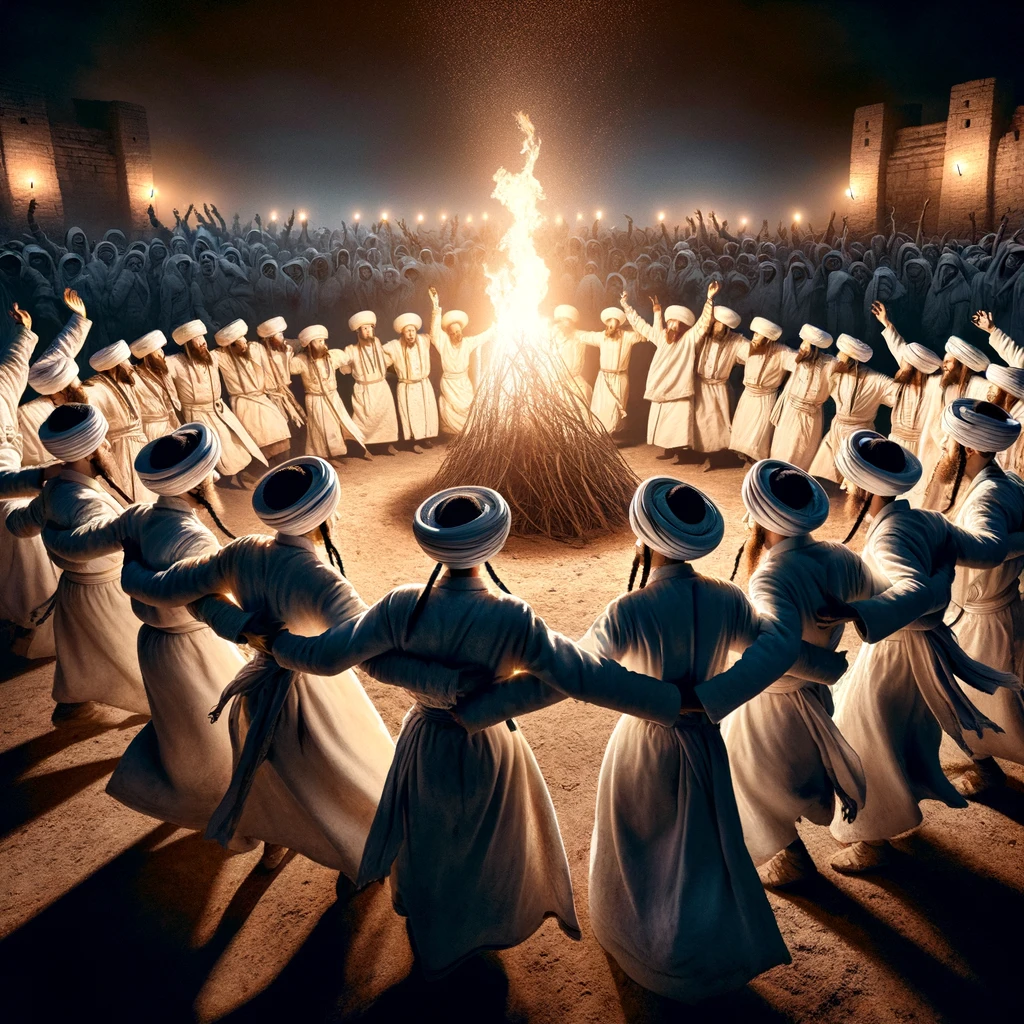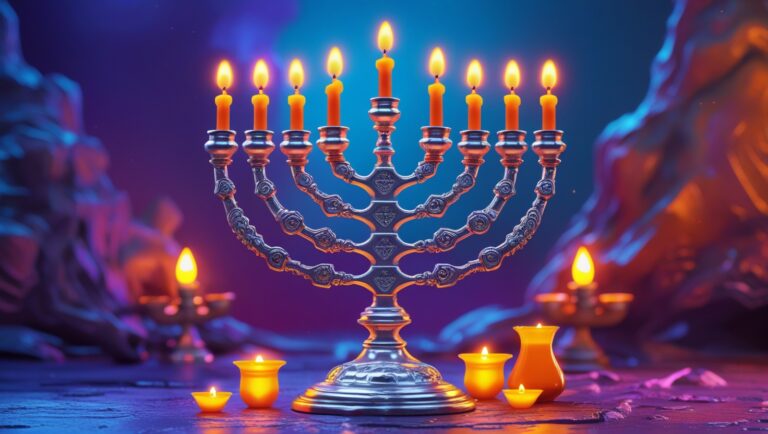To grasp a little of the significance of Rabbi Shimon Bar Yochai (also known as Rashbi), we must consider his immense influence on Creation as a whole.
Rabbi Shimon Bar Yochai remains one of the most cherished Tannaim in the hearts of the Jewish nation. Even today, over half a million people gather in Meron for his Hilula (death anniversary) during Lag Baomer, a testament to the lasting impact of his legacy, an honor which no other sage ever merited.
As most of us know, Rabbi Shimon Bar Yochai’s most notable contribution to the world is the book of Zohar, which serves as the foundation for the wisdom of Kabbalah and that has been embraced by all true Tzaddikim.
No, seriously, download this booklet (not my authorship) that brings what Tzadikkim say about studying the Sefer HaZohar.
The significance of the Zohar cannot be overstated. In fact, many Sephardic communities used to keep two holy arks in their synagogues: one for the Torah and one for this sacred book. Rashbi’s sanctity is imbued within the very words of the Zohar, which contain countless stories that conceal some of the greatest secrets of Jewish mysticism.
The reason why it’s written in Aramaic is taught by the Arizal: The klipot (the side of evil) cannot understand Hebrew, but they can understand other languages like Aramaic. When we pray or study in Hebrew, we are protecting our words from the forces of evil so they don’t attach themselves to them and become stronger (this is a real concern, not every study or prayer is equal).
The book of the Zohar is so powerful and holy that we want the forces of evil to hear it and burn. The same applies to the Kaddish.

A little about Rabbi Shimon Bar Yochai
Rabbi Shimon Bar Yochai (also known as Rashbi) was one of the greatest Jewish sage who lived in the 2nd century CE (dates may vary, but this one comes from Wikipedia) during the period of Roman rule in Israel. He was a disciple of Rabbi Akiva and became one of the most important figures in the development of Jewish mysticism and Kabbalah.
Rashbi was born in Galilee in a time when the Jewish people were oppressed by the Romans, and he lived through the Bar Kochba revolt against the Romans in 132-136 CE. After the revolt was crushed, Rashbi and his son Rabbi Elazar were forced to go into hiding in a cave for 13 years to escape Roman persecution. During this time, they studied Torah and received divine revelations, which were later recorded in the Zohar. This is the story everyone knows.
To be clear, all the Tannaim and Amoraim were also, without a doubt, master Kabbalists.
They knew many of the holy secrets of the Torah and had powerful Ruach HaKodesh (divine spirit). However, though we still retain some powerful books like the Sefer Yetzirah and Sefer HaBahir, we lost most of the tradition from before Rabbi Shimon Bar Yochai.
What seems to be clear is that Rashbi never saw the Second Temple, which only adds to his greatness.
In Sefer HaLikutim however, Rabbi Chaim Vital teaches that Rashbi achieved the level as Moshe Rabbenu after the sin of the golden calf.
For the skeptics: yes, maybe Rashbi didn’t write the Book of the Zohar since Rabbi Abba was his scribe, but there is no doubt that he’s the real author behind, as this is the consensus among virtually all Tzadikim throughout the ages, including the Arizal, the GRA, the Baal Shem Tov, the Rashash and the Ramchal.

The splendor of the Zohar
The insights from the Zohar on the inner workings of Creation continue to inspire and strengthen Jews to this day. The Zohar is a “mystical” work of Jewish literature that has become a primary text in Kabbalah, the Jewish mystical tradition.
Personally, I don’t like the word “mystical” because it implies occult or magic, which is a misnomer.
As mentioned, it was dictated by Rabbi Shimon Bar Yochai alongside his son Rabbi Elazar and written by Rabbi Abba, contains a plethora of secrets of Creation, encoded in the Aramaic language.
Rebbe Nachman of Breslov teaches in Likutey Moharan that Aramaic is considered to be the bridge between Hebrew and other languages, preserving some of the holiness of Hebrew. The Zohar is unique in that many Kabbalists believe that simply reading it without comprehending its contents is enough a powerful segulah that purifies the soul and brings a lot blessings. Of course, a deeper understanding of the text is always preferred, but even the act of reading it is believed to be a great practice.
The Idra Rabbah, found in Parshat Naso, tells the story of how Rashbi and nine other sages (each associated with a Sephira) explain the partzufim of the higher worlds. The Idra Zuta, found in Parashat Ha’azinu, features only seven sages who gather to hear the final secrets from Rashbi’s lips as he lies on his deathbed.
The Zohar teaches that there are four levels of interpretation of the Torah: Peshat (literal interpretation), Remez (hinted interpretation), Drash (homiletical interpretation), and Sod (mystical interpretation). Whilte it focuses primarily on the Sod level of interpretation, which reveals the hidden mystical secrets of the Torah, there are also some powerful stories filled with Mussar.
Finally, the Tikkuney HaZohar is a massive book comprising 70 Tikkunim, each one unraveling many secrets about the first word of the Torah, בראשית (Bereshit) alone! R’ Meir Paprish recommends reading the entire Tikkuney HaZohar during the month of Elul and the ten days of Tishrei (40 days total), a task that takes around 20 hours. It’s awe-inspiring to consider how much knowledge remains hidden in the remaining 79,979 words of the Torah.
Imagine that.
The Zohar also teaches that Creation is made up of ten emanations, known as the Sefirot. These Sefirot represent different aspects of Hashem’s emanations and are arranged in a specific order. There are many articles in the website that you can read to learn about them:
- Short Guide To The 10 Sephirot – Keter (Crown), The Supernal Will
- The Awesome Mysteries of Shavuot – How To Merit The Crowns of Blessings
- Kabbalistic Secrets Of Purim and the 4 Parshiot – Lifting The Most Difficult Spiritual Sparks From Netzach Through Drunkeness
- The Power Of Tikkun HaKlali From A Kabbalistic Perspective – Rebbe Nachman of Breslov’s Precious Spiritual Gift
The Light of Lag Baomer
Lag BaOmer is not officially a yom tov, but is certainly a Jewish holiday that falls on the 33rd day of the Omer, the period of 49 days between Pesach and Shavuot. There’s a major illumination from the name אכדטם, which holds the letters preceding the name אלוהים, hence the reason why the students of R’ Akiva stopped dying.
It is a day of joy and celebration, marked by bonfires, parades, and other festivities. While it is not one of the major holidays of the Jewish calendar, Lag BaOmer holds a special place in the hearts of many Jews, particularly those of Sephardic and Hasidic background.
Either way, one of the most distinctive features of Lag BaOmer is the lighting of bonfires, which is a practice that has roots in both Jewish and pagan traditions. Bonfires are a symbol of the spiritual enlightenment that Rabbi Shimon bar Yochai brought to the world through his teachings. Others suggest that the fires are a symbol of the great light that was revealed on the day of his death since the day Tzadikim die are more important than when they are born. I means they finished their work and graduated.

Here, we are all rectifying the Partzuf of Sephirat HaOmer (which is Chagat – Chessed, Gevurah and Tiferet) leading to Shavuot (Chabad – Chokhmah, Binah and Da’at). Each day is one of the 7 Sephirot of Z”A (Zeir Anpin) and Nukva (the Shekhina), and so most people have the basic Kavanah to count on the first day Chesed Shb’Chesed on day 1, Gevurah Shb’Chesed on day 2 and so on.
The Rashash (Rabbi Shalom Sharabi) and all the Siddurim with Kavanot change the order to be Chesed Shb’Chesed on day 1, Chesed Shb’Gevurah on day 2, and so on. Either way, Kavanah is only for the drawing down of the Chassadim and Gevurot, but not the order of the Mokhin.
For both views, Lag Baomer, falls on Hod Sh’bHod (splendor of splendor), in which we have a special illumination from the name אכדטם that puts a “break” on the forces of Gevurah that have been extant so far.
Another nice insight is that Sefirat HaOmer is divided into 2 parts, before and after Lag Baomer. Before it we have 32 days, which is Gematria לב (Lev – Heart), and after it, we have only 17 days left, which is Gematria טוב (Tov – Good).
Lag Baomer is the day when Rashbi passed away, though I heard some misguided people say it was actually only “his wedding” based on some “archeological findings” of some “version of the Zohar”, which happened to have a certain letter Tav (ת) with the lower leg missing. This then supposedly changed the meaning from the word “that died” (Shemet – שמת) to “that rejoiced [in his marriage]” (Samach – שמח).
Go figure.
But this shows a little bit about the importance of Emunat Chakhamim (faith in the sages/tzadikim), upon which the wisdom of Kabbalah rests. Ultimately, there will always be levels higher than our perception to ask questions, but we must always return to the basics and realize our understanding is small.
Saving the world from destruction
The power of our sages are beyond comprehension. Every single one of the sages mentioned in the Talmud had the power to revive the dead. This was like a basic requirement to have his name written there.
The story of how Rabbi Shimon Bar Yochai saved the world when he encountered a massive destroying angel tasked who wielded 30 fire balls to bring about the end of the world.
Despite the angel’s ominous warning, Rashbi fearlessly asserted that he and his companions could atone for the entire world, or failing that, he himself would handle the matter. The angel was sent to Hashem and back multiple times, and even threatened with being sent to Gehinom, until a heavenly voice praised Rashbi for his ability to decree and annul at will, and Hashem’s willingness to fulfill his words.
Another instance of Rashbi’s power is demonstrated when he quelled a deadly plague with a single sentence “can it be that there’s a plague and I in the same city?” Rabbi Meir Ba’al HaNes praised Rashbi for his unique ability to save lives with such ease, comparing it to Moshe Rabbenu’s more elaborate process of having to blend incense through Aharon.
I explained here in this article the reason for this seeming discrepancy owing to the fact that no one was greater than Moshe Rabbenu. You can also check the video below:
Anyway, Rashbi remains one of the most beloved figure in Jewish history, particularly for his role as the author of the Zohar. Interestingly his Hilula on Lag Baomer leads as the greatest Jewish gathering in every year (at least 500.000 in regular years). This is followed by, of course, Uman Rosh Hashana when Rebbe Nachman gathers 60.000 in regular years.
Lag Baomer is a day filled with light and that has incredible power and is happening very soon! Many people have the custom to learn the Kuntres Hilula D’Rashbi of the Ben Ish Chai in which he brings many stories and praises of Rabbi Shimon Bar Yochai from the Zohar together.
Let’s make the most out of it and may Hashem send us our salvation in the merit of Rashbi.







